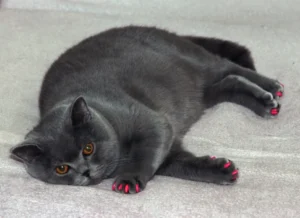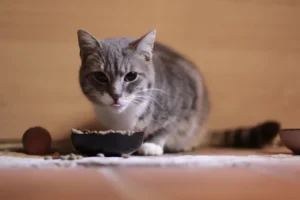Seems like your fluffy overlord has been sneaking a few too many treats, resulting in a tiny medical hiccup called diabetes. While Mr. Whiskers figures out why his nine lives don’t come with a free gym membership, let’s talk turkey—or rather, low-carb kibble.
In this post, you’ll discover how to turn a distressing diagnosis into a manageable mealtime routine that keeps your feline friend purring for many years to come.
Key takeaways:
- Implement a regular feeding and insulin schedule to stabilize your diabetic cat’s blood sugar levels.
- Choose a high-protein, low-carbohydrate diet, and avoid sudden changes to prevent glucose spikes.
- Opt for diabetic-friendly treats and non-food rewards to indulge your cat without impacting blood sugar control.
What Does Diabetes in Cats Really Mean for Their Diet?
When a cat has diabetes, their body either doesn’t produce enough insulin or can’t use the insulin effectively to regulate blood sugar levels.
Imagine a lock and key – in diabetic cats, the key (insulin) doesn’t fit the lock (cells) quite right, so the door (glucose entry) remains closed, leading to a buildup of sugar in the blood. This imbalance can take a toll on a kitty’s health, and that’s where diet plays a starring role.
Diet management is the cornerstone for controlling this condition. By maintaining a consistent intake of the right nutrients, we can help our feline friends keep their blood sugar levels as stable as possible. This not only reduces the risk of diabetes-related complications but also can improve their energy levels and overall quality of life.
What Can You Do to Monitor Your Diabetic Cat’s Eating Habits?
Monitoring your diabetic cat’s diet is a balancing act, but with a few strategic moves, it can become second nature:
- Keep a Food Diary: It’s not just a tool for humans on a health kick! Jot down what your cat eats and when, noting their reaction to different foods.
- Timely Meals: Cats with diabetes benefit from a regular feeding schedule. Aim to align meal times with insulin administration, typically twice a day.
- Portion Patrol: Ensure your cat’s portions are measured. Too much food can spike blood sugar levels while too little can lead to hypoglycemia.
- Consistency Is Key: Stick to the same food type and brand once you find what works well for their blood sugar levels.
A pro tip – invest in a pet scale. Regular weigh-ins can help you fine-tune their diet and notice any weight changes that may indicate the need for dietary adjustments.
Does Your Cat Need a Special Kind of Food?
Absolutely! The right chow can be a game-changer for cats with diabetes.
Prescription Diets: These are specially formulated to have low carbohydrate content and high protein levels, making them an excellent option for diabetic felines. Your vet might recommend a prescription diet like Hill’s Prescription Diet m/d Glucose/Weight Management, tailored to a diabetic cat’s needs.
Wet Food Wonders: Low-carb wet foods can be a more natural choice, considering cats are carnivores. They often have fewer carbs than dry kibble and can also keep your cat well-hydrated.
Transitioning Tips: If you’re introducing new food, do it gradually. Mix it with the familiar fare and slowly increase the ratio over a week or so, monitoring their blood glucose levels to ensure they remain stable.
Here’s the scoop most owners miss: while ‘grain-free’ often sounds like a synonym for ‘low-carb’, not all grain-free foods are low in carbohydrates. Read labels carefully!
Now, this is not where our cat care chapter closes. There’s more to dive into when managing a cat with diabetes, but getting their diet right is a solid start to a happy and healthy life for our four-legged companions. Stay tuned for more insights on keeping your diabetic cat in tip-top shape.
How Do You Balance Insulin With Diet?
Balancing insulin with diet is a bit like a delicate dance between what your cat eats and how their body responds to it. Insulin therapy is essential for controlling your cat’s blood sugar levels, and when you pair it with the right diet, you’re setting the stage for a seamless performance.
When it comes to coordinating meals with insulin administration, timing really is everything. Here’s why: insulin helps glucose enter the body’s cells, which is crucial after your cat has eaten. By aligning your cat’s meal times with their insulin injections, you’re ensuring that the insulin is at its most effective when your cat’s blood sugar is on the rise.
Here are a few guidelines to prevent those pesky sugar spikes:
- Consistency is key: Aim to feed your cat and administer insulin at the same times every day. This routine helps regulate their blood sugar levels.
- The right match: Work with your vet to determine the best type of insulin for your cat’s needs and how it pairs with meal times. Some insulins work quickly and are best given right at mealtime, while others might need to be administered a bit before eating.
- Slow and steady: Opt for food that releases energy slowly. Foods that are high in protein and low in carbohydrates are often recommended for diabetic cats because they cause a more gradual increase in blood sugar levels.
Keep a close eye on your furball’s response to their new diet and insulin routine. Regular check-ins with your vet can help you tweak things to perfection.
What About Treats and Scraps – Are They Off the Table?
We all love pampering our pets, and when those big eyes are pleading, saying “no” to treats can be tough. While it’s true that managing a diabetic cat’s diet means you might have to rein in the treats, it doesn’t mean they’re totally off the menu.
Instead of reaching for the usual carb-laden kitty snacks, why not try:
- Healthy alternatives: Treat them with small portions of foods that fit within their diabetic diet. Think bite-sized pieces of cooked chicken or fish.
- Veggie delights: Some cats enjoy munching on veggies. Offer them a crunch with a few small pieces of steamed broccoli or sliced cucumber.
- Non-edible rewards: Show love in ways other than food. A good ear scratch, a new toy, or quality playtime can be just as satisfying (if not more!) for your feline friend.
One unique tip? Create a ‘treasure hunt’ by hiding their diabetic-friendly treats around the house. It’ll stimulate their mind and get them moving, addressing both their mental and physical health – a win-win!
Treats should be just that – occasional and not a staple of their diet. If you’re ever in doubt, have a chat with your vet to ensure any treats you’re considering are safe for your diabetic pal.
By using these approaches to manage your cat’s diabetes, you’re not just managing a condition; you’re enriching their life. It’s all about finding that sweet spot where their health needs and their happiness meet. And isn’t that what we all want for our furry loved ones?
Alex, a passionate animal lover, has experience in training and understanding animal behavior. As a proud pet parent to two dogs and three cats, he founded AnimalReport.net to share insights from animal experts and expand his knowledge of the animal kingdom.










